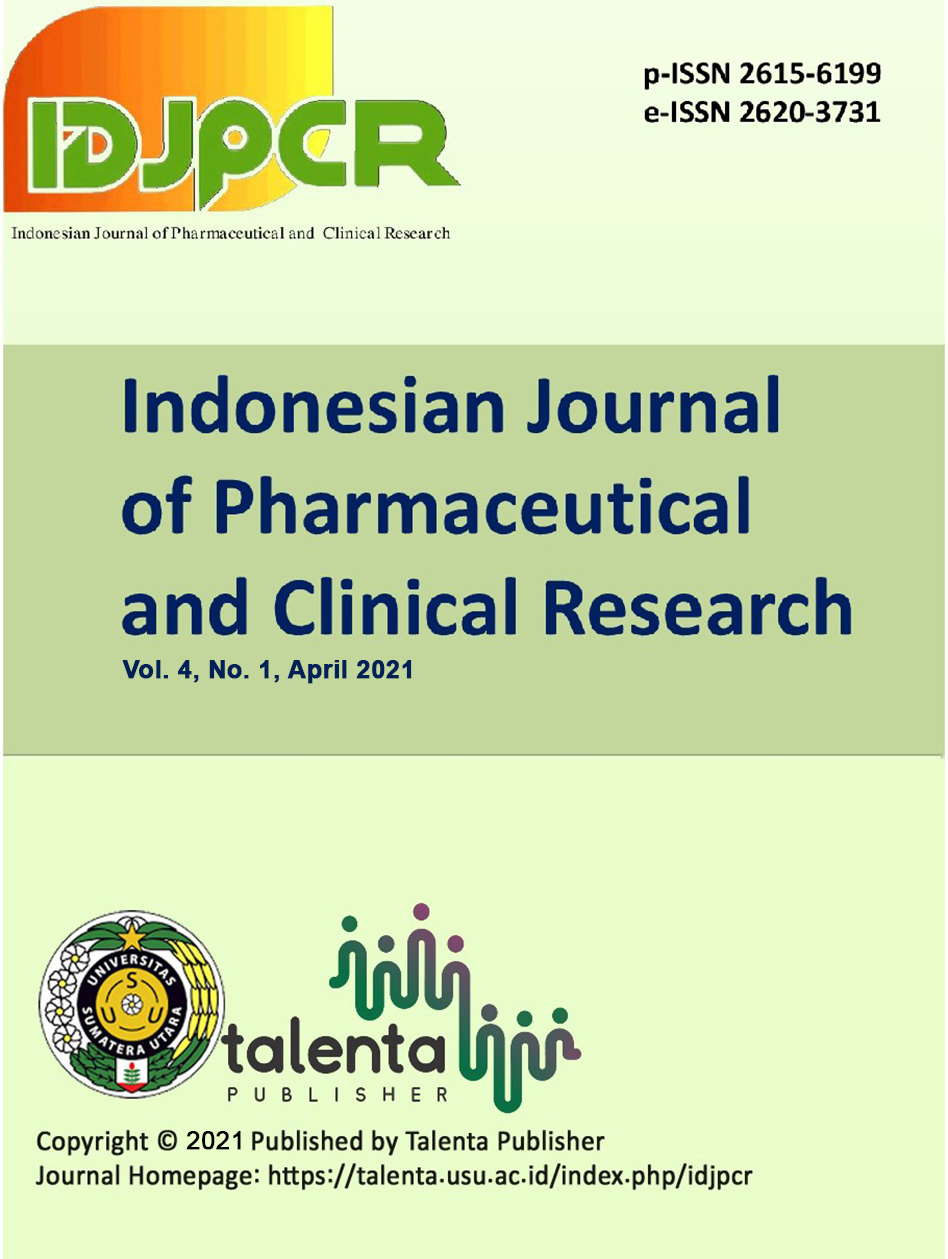Rational Use of Medicine in the Treatment of Helminth Infection : A Mini Review
DOI:
https://doi.org/10.32734/idjpcr.v4i1.5375Keywords:
Medicine, Soil transmitted helminth, worm infection, antihelminthicAbstract
Indonesia still has health problem, especially soil transmitted helminth. These helminths can cause deteriorate health, nutrition, intelligence and productivity of patients so causes a lot of losses economically. The aim of this article is to review the rational treatment of helminth infection. Albendazole, mebendazole, and pyrantel pamoate are the drugs recommended by the WHO. However, the uses of the three are different, especially for mass treatment or selective medicine. This review conclude that the three drugs are used according to the target patient's age with dosages and preparations that must be adjusted.
Downloads
References
. D. Glinz, K. D. Silué, S. Knopp, L. K. Lohourignon, K. P. Yao, P. Steinmann, L. Rinaldi, G. Cringoli, E. K. N’Goran, and J. Utzinger, “Comparing Diagnostic Accuracy of Kato-Katz, Koga Agar Plate, Ether-Concentration, and FLOTAC for Schistosoma mansoni and Soil-Transmitted Helminths,†PLoS Neglected Tropical Diseases, vol. 4, no. 7, p. e754, Jul. 2010.
. M. Mbong Ngwese, G. Prince Manouana, P. A. Nguema Moure, M. Ramharter, M. Esen, and A. A. Adégnika, “Diagnostic Techniques of Soil-Transmitted Helminths: Impact on Control Measures,†Tropical Medicine and Infectious Disease, vol. 5, no. 2, p. 93, Jun. 2020.
. G. Cringoli, L. Rinaldi, M. P. Maurelli, and J. Utzinger, “FLOTAC: new multivalent techniques for qualitative and quantitative copromicroscopic diagnosis of parasites in animals and humans,†Nature Protocols, vol. 5, no. 3, pp. 503–515, Feb. 2010.
. M. D. Lim, S. J. Brooker, V. Y. Belizario, F. Gay-Andrieu, J. Gilleard, B. Levecke, L. van Lieshout, G. F. Medley, Z. Mekonnen, G. Mirams, S. M. Njenga, M. R. Odiere, J. W. Rudge, L. Stuyver, J. Vercruysse, J. Vlaminck, and J. L. Walson, “Diagnostic tools for soil-transmitted helminths control and elimination programs: A pathway for diagnostic product development,†PLOS Neglected Tropical Diseases, vol. 12, no. 3, p. e0006213, Mar. 2018.
. V. Margarita, P. L. Fiori, and P. Rappelli, “Impact of Symbiosis Between Trichomonas vaginalis and Mycoplasma hominis on Vaginal Dysbiosis: A Mini Review,†Frontiers in Cellular and Infection Microbiology, vol. 10, May 2020.
. A. Spotin, H. R. Moslemzadeh, M. Mahami-Oskouei, E. Ahmadpour, M. Niyyati, S. H. Hejazi, F. Memari, and J. Noori, “Phylogeography, genetic variability and structure of Acanthamoeba metapopulations in Iran inferred by 18S ribosomal RNA sequences: A systematic review and meta-analysis,†Asian Pacific Journal of Tropical Medicine, vol. 10, no. 9, pp. 855–863, Sep. 2017.
. S. Angelone-Alasaad, A. Molinar Min, M. Pasquetti, A. N. Alagaili, S. D’Amelio, F. Berrilli, V. Obanda, M. A. Gebely, R. C. Soriguer, and L. Rossi, “Universal conventional and real-time PCR diagnosis tools for Sarcoptes scabiei,†Parasites & Vectors, vol. 8, no. 1, Nov. 2015.
. S. S. Y. Wong, R. W. S. Poon, S. Chau, S. C. Y. Wong, K. K. W. To, V. C. C. Cheng, K. S. C. Fung, and K. Y. Yuen, “Development of Conventional and Real-Time Quantitative PCR Assays for Diagnosis and Monitoring of Scabies,†Journal of Clinical Microbiology, vol. 53, no. 7, pp. 2095–2102, Apr. 2015.
. H. Gunawan, U. Sugiri, Nurhasanah, K. Makarti, and O. Suwarsa, “Oral Clindamycin as Drug of Choice for Scabies Patients with Secondary Bacterial Infections in West Java, Indonesia,†American Journal of Infectious Diseases, vol. 14, no. 1, pp. 45–50, Jan. 2018.
. P. Delaunay, A. L. Hérissé, L. Hasseine, C. Chiaverini, A. Tran, C. Mary, P. Del Giudice, P. Marty, M. Akhoundi, and T. Hubiche, “Scabies polymerase chain reaction with standardized dry swab sampling: an easy tool for cluster diagnosis of human scabies,†British Journal of Dermatology, Aug. 2019.
. M. Bae, J. Y. Kim, J. Jung, H. H. Cha, N.-Y. Jeon, H.-J. Lee, M. J. Kim, S. E. Chang, and S.-H. Kim, “Diagnostic value of the molecular detection of Sarcoptes scabiei from a skin scraping in patients with suspected scabies,†PLOS Neglected Tropical Diseases, vol. 14, no. 4, p. e0008229, Apr. 2020.
. S. Naz, F. R. Chaudhry, D. A. Rizvi, and M. Ismail, “Phylogenetic Analysis of Astigmatid Mites Sarcoptes scabiei and Dermatophagoides farinae using ITS-2 as a Genetic Marker,†Life and Science, vol. 1, no. 2, p. 5, Apr. 2020.
. C. Aubernon, V. Hédouin, and D. Charabidzé, “Les larves de diptères nécrophages en entomologie médico-légale : une histoire de température,†médecine/sciences, vol. 33, no. 8–9, pp. 779–783, Aug. 2017.
. S. Matuszewski, M. J. R. Hall, G. Moreau, K. G. Schoenly, A. M. Tarone, and M. H. Villet, “Pigs vs people: the use of pigs as analogues for humans in forensic entomology and taphonomy research,†International Journal of Legal Medicine, vol. 134, no. 2, pp. 793–810, Jun. 2019.
. H. Jordan and J. Tomberlin, “Abiotic and Biotic Factors Regulating Inter-Kingdom Engagement between Insects and Microbe Activity on Vertebrate Remains,†Insects, vol. 8, no. 2, p. 54, May 2017.
. K. Sukontason, S. Piangjai, S. Siriwattanarungsee, and K. L. Sukontason, “Morphology and developmental rate of blowflies Chrysomya megacephala and Chrysomya rufifacies in Thailand: application in forensic entomology,†Parasitology Research, vol. 102, no. 6, pp. 1207–1216, Feb. 2008.
. K. L. Sukontason, S. Sanit, T. Klong-klaew, J. K. Tomberlin, and K. Sukontason, “Sarcophaga (Liosarcophaga) dux (Diptera: Sarcophagidae): A flesh fly species of medical importance,†Biological Research, vol. 47, no. 1, Apr. 2014.
Downloads
Published
How to Cite
Issue
Section
License
Copyright (c) 2021 Indonesian Journal of Pharmaceutical and Clinical Research

This work is licensed under a Creative Commons Attribution-ShareAlike 4.0 International License.
The Authors submitting a manuscript do so on the understanding that if accepted for publication, copyright of the article shall be assigned to Indonesian Journal of Pharmaceutical and Clinical Research (IDJPCR) and Faculty of Pharmacy as well as TALENTA Publisher Universitas Sumatera Utara as publisher of the journal.
Copyright encompasses exclusive rights to reproduce and deliver the article in all form and media. The reproduction of any part of this journal, its storage in databases and its transmission by any form or media, will be allowed only with a written permission from Indonesian Journal of Pharmaceutical and Clinical Research (IDJPCR).
The Copyright Transfer Form can be downloaded here.
The copyright form should be signed originally and sent to the Editorial Office in the form of original mail or scanned document.









